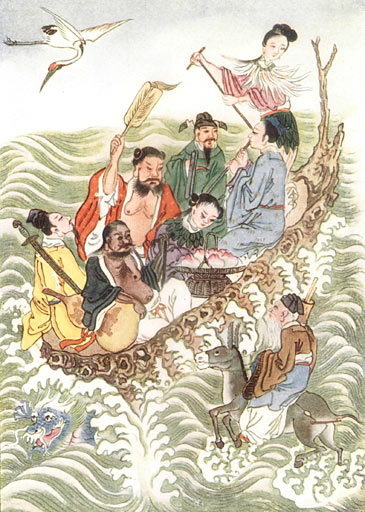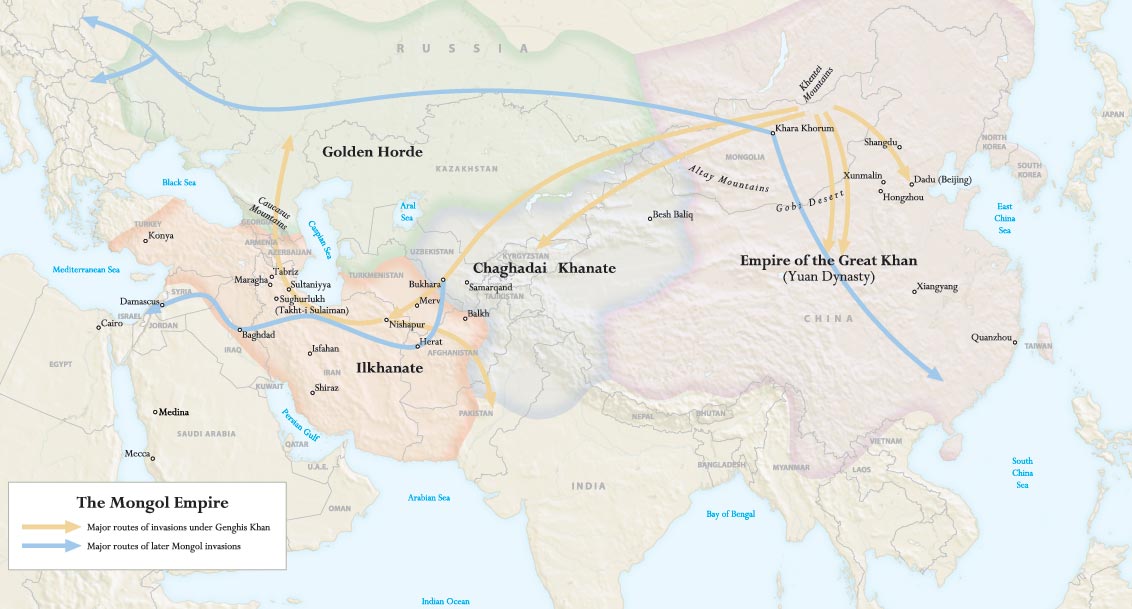|
Eight Immortals (other)
The Eight Immortals () are a group of legendary '' xian (immortals)'' in Chinese mythology. Each immortal's power can be transferred to a vessel () that can bestow life or destroy evil. Together, these eight vessels are called the "Covert Eight Immortals" (). Most of them are said to have been born in the Tang or Song Dynasty. They are revered by the Taoists and are also a popular element in secular Chinese culture. They are said to live on a group of five islands in the Bohai Sea, which includes Mount Penglai. The Immortals are: * He Xiangu (), in modern context generally seen as the only female of the group, often depicted holding a lotus flower. * Cao Guojiu (), related to a Song dynasty emperor before he became an immortal. * Li Tieguai (), considered to be mentally disturbed and associated with medicine and easing the suffering of the sick and needy, identified by his iron crutch and calabash bottle. * Lan Caihe (), originally pictured as female; later developed an ambiguou ... [...More Info...] [...Related Items...] OR: [Wikipedia] [Google] [Baidu] |
Lake Heihai
Lake Heihai is a small meso saline lake in Golmud County, Haixi Prefecture, Qinghai Province, in western China. Names "Lake Heihai" is an English clarification of the pinyin romanization of the Chinese name meaning . (As with Qinghai Lake, the Chinese word for "sea" is sometimes used to translate the Mongolian ''naɣur'' (), which was once used ambiguously for all large bodies of water.) The lake is also known as ("Jade Pond of the Queen Mother of the West") from an old legendary location in the Kunlun Mountains and sometimes confused with Lake Hala in the Qilian Mountains. Geography Lake Heihai is located about south of the city of Golmud in Golmud County, Haixi Prefecture, Qinghai Province, at an elevation of or above sea level in western China. It lies in a valley roughly long and wide between the Kunlun Mountains (highest elevation about ) to the south and the Burhan Buda (highest elevation about ) to the north. Earthquakes are common, as the lake lies near t ... [...More Info...] [...Related Items...] OR: [Wikipedia] [Google] [Baidu] |
Han Xiangzi
Han Xiangzi, courtesy name Qingfu or Beizhu, is a Chinese mythological figure and one of the Eight Immortals in the Taoist pantheon. He studied Taoist magical arts under the tutelage of Lü Dongbin, another of the Eight Immortals. Han Xiangzi is often depicted carrying a '' dizi'' (Chinese flute), so he is also regarded as the patron deity of flutists. He is also believed to be the composer of the Taoist musical piece ''Tian Hua Yin'' (). Historical identity It is not known if Han Xiangzi existed historically. However, he is believed to be Han Xiang, a grandnephew of Han Yu, a prominent politician, poet and Confucian scholar who lived in the Tang dynasty. There are at least three different accounts about Han Xiang and Han Yu's grandnephew. Han Yu once dedicated three poems to his grandnephew, Han Xiang, whose courtesy name was "Qingfu". The three poems are ''Zuo Qian Zhi Languan Shi Zhisun Xiang'' (), and the two-part poem ''Su Zeng Jiang Kou Shi Zhisun Xiang'' (). In 819, during ... [...More Info...] [...Related Items...] OR: [Wikipedia] [Google] [Baidu] |
Fu Lu Shou
The Sanxing () are the gods of the three stars or constellations considered essential in Chinese astrology and mythology: Jupiter, Ursa Major, and Canopus. Fu, Lu, and Shou (), or Cai, Zi and Shou () are also the embodiments of Fortune ( Fu), presiding over the planet Jupiter, Prosperity (Lu), presiding over Mizar, and Longevity (Shou), presiding over Canopus. They have emerged from Chinese folk religion. Their iconic representation as three, old, bearded, wise men dates back to the Ming dynasty, when the gods of the three stars were represented in human form for the first time. They are sometimes identified with other deities of the Chinese religion or of Taoism. The term is commonly used in Chinese culture to denote the three attributes of a good life. Statues of these three gods are found on the facades of folk religion's temples and ancestral shrines, in nearly every Chinese home and many Chinese-owned shops on small altars with a glass of water, an orange or other auspicious ... [...More Info...] [...Related Items...] OR: [Wikipedia] [Google] [Baidu] |
Qing Dynasties
The Qing dynasty ( ), officially the Great Qing,, was a Manchu-led imperial dynasty of China and the last orthodox dynasty in Chinese history. It emerged from the Later Jin dynasty founded by the Jianzhou Jurchens, a Tungusic-speaking ethnic group who unified other Jurchen tribes to form a new "Manchu" ethnic identity. The dynasty was officially proclaimed in 1636 in Manchuria (modern-day Northeast China and Outer Manchuria). It seized control of Beijing in 1644, then later expanded its rule over the whole of China proper and Taiwan, and finally expanded into Inner Asia. The dynasty lasted until 1912 when it was overthrown in the Xinhai Revolution. In orthodox Chinese historiography, the Qing dynasty was preceded by the Ming dynasty and succeeded by the Republic of China. The multiethnic Qing dynasty lasted for almost three centuries and assembled the territorial base for modern China. It was the largest imperial dynasty in the history of China and in 1790 the four ... [...More Info...] [...Related Items...] OR: [Wikipedia] [Google] [Baidu] |
Ming Dynasty
The Ming dynasty (), officially the Great Ming, was an Dynasties in Chinese history, imperial dynasty of China, ruling from 1368 to 1644 following the collapse of the Mongol Empire, Mongol-led Yuan dynasty. The Ming dynasty was the last orthodox dynasty of China ruled by the Han Chinese, Han people, the majority ethnic group in China. Although the primary capital of Beijing fell in 1644 to a rebellion led by Li Zicheng (who established the short-lived Shun dynasty), numerous rump state, rump regimes ruled by remnants of the House of Zhu, Ming imperial family—collectively called the Southern Ming—survived until 1662. The Ming dynasty's founder, the Hongwu Emperor (r. 1368–1398), attempted to create a society of self-sufficient rural communities ordered in a rigid, immobile system that would guarantee and support a permanent class of soldiers for his dynasty: the empire's standing army exceeded one million troops and the naval history of China, navy's dockyards in Nanjin ... [...More Info...] [...Related Items...] OR: [Wikipedia] [Google] [Baidu] |
Celadon
''Celadon'' () is a term for pottery denoting both wares glazed in the jade green celadon color, also known as greenware or "green ware" (the term specialists now tend to use), and a type of transparent glaze, often with small cracks, that was first used on greenware, but later used on other porcelains. Celadon originated in China, though the term is purely European, and notable kilns such as the Longquan kiln in Zhejiang province are renowned for their celadon glazes. Celadon production later spread to other parts of East Asia, such as Japan and Korea as well as Southeast Asian countries such as Thailand. Eventually, European potteries produced some pieces, but it was never a major element there. Finer pieces are in porcelain, but both the color and the glaze can be produced in stoneware and earthenware. Most of the earlier Longquan celadon is on the border of stoneware and porcelain, meeting the Chinese but not the European definitions of porcelain. For many centuries ... [...More Info...] [...Related Items...] OR: [Wikipedia] [Google] [Baidu] |
Jin Dynasty, 1115–1234
Jin is a toneless pinyin romanization of various Chinese names and words. These have also been romanized as Kin and Chin (Wade–Giles). "Jin" also occurs in Japanese and Korean. It may refer to: States Jìn 晉 * Jin (Chinese state) (晉國), major state of the Zhou dynasty, existing from the 11th century BC to 376 BC * Jin dynasty (266–420) (晉朝), also known as Liang Jin and Sima Jin * Jin (Later Tang precursor) (晉國; 907–923), Five Dynasties and Ten Kingdoms period * Later Jin (Five Dynasties) (後晉; 936–947), Five Dynasties and Ten Kingdoms period Jīn 金 * Jin dynasty (1115–1234) (金朝), also known as the Jurchen Jin * Later Jin (1616–1636) (後金; 1616–1636), precursor of the Qing dynasty Others * Jin (Korean state) (辰國), precursor of the Jinhan Confederation * Balhae (698–713), originally known as Jin (震) Places * Jin Prefecture (Shanxi) (晉州), a former Chinese prefecture centered on present-day Linfen, Shanxi * Jin Prefecture (Sha ... [...More Info...] [...Related Items...] OR: [Wikipedia] [Google] [Baidu] |
Han Dynasty
The Han dynasty (, ; ) was an Dynasties in Chinese history, imperial dynasty of China (202 BC – 9 AD, 25–220 AD), established by Emperor Gaozu of Han, Liu Bang (Emperor Gao) and ruled by the House of Liu. The dynasty was preceded by the short-lived Qin dynasty (221–207 BC) and a warring interregnum known as the ChuHan contention (206–202 BC), and it was succeeded by the Three Kingdoms period (220–280 AD). The dynasty was briefly interrupted by the Xin dynasty (9–23 AD) established by usurping regent Wang Mang, and is thus separated into two periods—the #Western Han, Western Han (202 BC – 9 AD) and the #Eastern Han, Eastern Han (25–220 AD). Spanning over four centuries, the Han dynasty is considered a golden age (metaphor), golden age in Chinese history, and it has influenced the identity of the History of China, Chinese civilization ever since. Modern China's majority ethnic group refers to themselves as the "Han Chinese, Han people", the Sinitic langu ... [...More Info...] [...Related Items...] OR: [Wikipedia] [Google] [Baidu] |
Chinese - The Eight Immortals - Walters 3535
Chinese can refer to: * Something related to China * Chinese people, people of Chinese nationality, citizenship, and/or ethnicity **''Zhonghua minzu'', the supra-ethnic concept of the Chinese nation ** List of ethnic groups in China, people of various ethnicities in contemporary China ** Han Chinese, the largest ethnic group in the world and the majority ethnic group in Mainland China, Hong Kong, Macau, Taiwan, and Singapore ** Ethnic minorities in China, people of non-Han Chinese ethnicities in modern China ** Ethnic groups in Chinese history, people of various ethnicities in historical China ** Nationals of the People's Republic of China ** Nationals of the Republic of China ** Overseas Chinese, Chinese people residing outside the territories of Mainland China, Hong Kong, Macau, and Taiwan * Sinitic languages, the major branch of the Sino-Tibetan language family ** Chinese language, a group of related languages spoken predominantly in China, sharing a written script (Chinese ... [...More Info...] [...Related Items...] OR: [Wikipedia] [Google] [Baidu] |
Eight Immortals Of Huainan
The Eight Gentlemen of Huainan () were the eight scholars under the patronage of Liu An (劉安 Liú Ān), the prince of Huainan during the Western Han Dynasty. Together, they wrote the philosophical collection ''Huainanzi The ''Huainanzi'' is an ancient Chinese text that consists of a collection of essays that resulted from a series of scholarly debates held at the court of Liu An, Prince of Huainan, sometime before 139. The ''Huainanzi'' blends Daoist, Confu ...'' (淮南子, Huáinánzǐ, literally "The Philosophers of Huainan"). They were: * Jin Chang (晋昌 Jìn Chāng), * Lei Bei (雷被 Léi Bèi), * Li Shang (李尚 Lǐ Shàng), * Mao Bei (毛被 Máo Bèi), * Su Fei (苏飞 Sū Fēi), * Tian You (田由 Tián Yóu), * Wu Bei (伍被 Wǔ Bèi), and * Zuo Wu (左吴 Zuǒ Wú). The "Bagong Mountain" ("Eight Gentlemen Mountain") in China is named after them. 8 Eight Immortals of Huainan 2nd-century BC Chinese people Articles about multiple people in pre-Tang ... [...More Info...] [...Related Items...] OR: [Wikipedia] [Google] [Baidu] |
Yuan Dynasty
The Yuan dynasty (), officially the Great Yuan (; xng, , , literally "Great Yuan State"), was a Mongols, Mongol-led Dynasties in Chinese history, imperial dynasty of China and a successor state to the Mongol Empire after Division of the Mongol Empire, its division. It was established by Kublai Khan, Kublai, the fifth khagan-emperor of the Mongol Empire from the Borjigin clan, and lasted from 1271 to 1368. In orthodox Chinese historiography, the Yuan dynasty followed the Song dynasty and preceded the Ming dynasty. Although Genghis Khan had been enthroned with the Han Chinese, Han-style title of Emperor of China, Emperor in 1206 and the Mongol Empire had ruled territories including modern-day Northern and southern China, northern China for decades, it was not until 1271 that Kublai Khan officially proclaimed the dynasty in the traditional Han style, and the conquest was not complete until 1279 when the Southern Song dynasty was defeated in the Battle of Yamen. His realm was, ... [...More Info...] [...Related Items...] OR: [Wikipedia] [Google] [Baidu] |
Jinn
Jinn ( ar, , ') – also romanized as djinn or anglicized as genies (with the broader meaning of spirit or demon, depending on sources) – are invisible creatures in early pre-Islamic Arabian religious systems and later in Islamic mythology and theology. Like humans, they are accountable for their deeds, can be either believers (''Muslim'') or unbelievers (''kafir''); depending on whether they accept God's guidance. Since jinn are neither innately evil nor innately good, Islam acknowledged spirits from other religions and was able to adapt spirits from other religions during its expansion. Jinn are not a strictly Islamic concept; they may represent several Religion in pre-Islamic Arabia, pagan beliefs integrated into Islam. To assert a strict monotheism and the Islamic concept of ''Tauhid'', Islam denies all affinities between the jinn and God, thus placing the jinn parallel to humans, also subject to God's judgment and afterlife. The Quran condemns the pre-Islamic ... [...More Info...] [...Related Items...] OR: [Wikipedia] [Google] [Baidu] |







